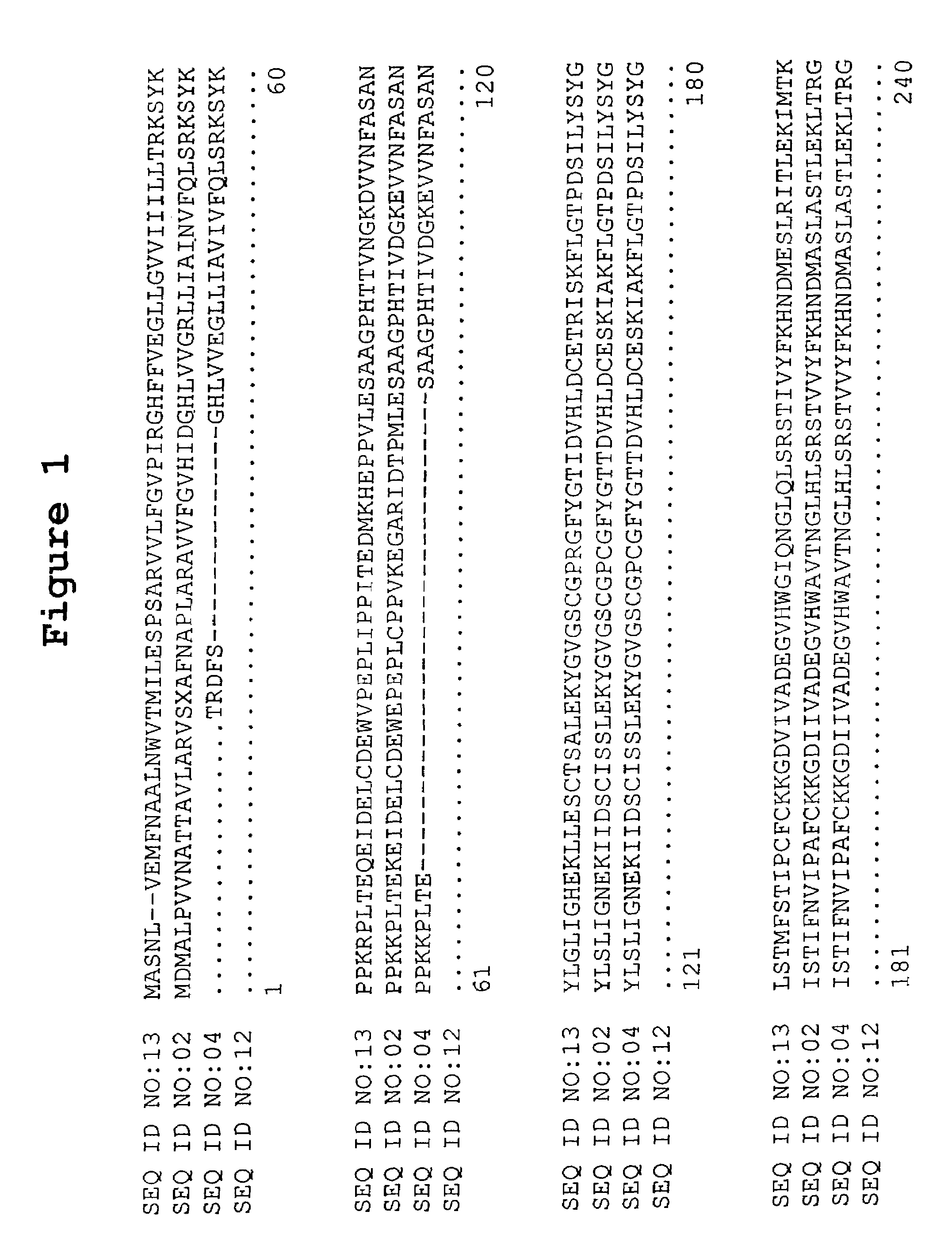Lcb1 subunit of serine palmitoyltransferase
- Summary
- Abstract
- Description
- Claims
- Application Information
AI Technical Summary
Benefits of technology
Problems solved by technology
Method used
Image
Examples
example 1
Composition of cDNA Libraries; Isolation and Sequencing of cDNA Clones
[0068]cDNA libraries representing mRNAs from various corn, rice, soybean and wheat tissues were prepared. The characteristics of the libraries are described below.
[0069]
TABLE 2cDNA Libraries from Corn, Rice, Soybean and WheatLibraryTissueCloneeco1nCorn Cob of 67 Day Old Plantscco1n.pk060.d3Grown in Green House*ceb3Corn Embryo 20 Days After Pollinationceb3.pk0002.d5cen3nCorn Endosperm 20 Days After Pollination*cen3n.pk0067.a2cr1nCorn Root From 7 Day Old Seedlings*cn1n.pk0001.e6p0010Log Phase Suspension Cells (BMS) Treatedp0010.cbpaa34rbWith A23187**p0010.cbpad89rbrca1nRice Callus*rca1n.pk009.h2r1r12Rice Leaf 15 Days After Germination, 12r1s12.pk0012.d2Hours After Infection of Strain Magaporthegrisea 4360-R-62 (AVR2-YAMO); Resistantsrr1cSoybean 8-Day-Old Rootsrr1c.pk002.k24w1m4Wheat Seedlings 4 Hours After Inoculationw1m4.pk0022.f3With Erysiphe graminis f. sp tritici*These libraries were normalized essentially as de...
example 2
Identification of cDNA Clones
[0071]ESTs encoding serine palmitoyltransferase Lcb1 subunits were identified by conducting BLAST (Basic Local Alignment Search Tool; Altschul, S. F., et al., (1993) J. Mol. Biol. 215:403-410) searches for similarity to sequences contained in the BLAST “nr” database (comprising all non-redundant GenBank CDS translations, sequences derived from the 3-dimensional structure Brookhaven Protein Data Bank, the last major release of the SWISS-PROT protein sequence database, EMBL, and DDBJ databases). The cDNA sequences obtained in Example 1 were analyzed for similarity to all publicly available DNA sequences contained in the “nr” database using the BLASTN algorithm provided by the National Center for Biotechnology Information (NCBI). The DNA sequences were translated in all reading frames and compared for similarity to all publicly available protein sequences contained in the “nr” database using the BLASTX algorithm (Gish, W. and States, D. J. (1993) Nature Gen...
example 3
Characterization of cDNA Clones Encoding Serine Palmitoyltransferase Lcb1 Subunit
[0072]The BLASTX search using the EST sequences from several corn, rice, soybean and wheat clones revealed similarity of the proteins encoded by the cDNAs to serine palmitoyltransferase Lcb1 subunit from several Arabidopsis thaliana and Homo sapiens. The Arabidopsis thaliana sequence has GenBank Accession No. Z99708 while the Homo sapiens sequence has GenBank Accession No. Y08685. In the process of comparing the corn ESTs it was found that clones cbn10.pk0005.h3, cepe7.pk0018.h4, cr1n.pk0184.f3, cs1.pk0009.h4 and csi1n.pk0021.c3 have overlapping regions of homology. Comparing the corn ESTs revealed that clones cr1n.pk0001.e6, cepe7.pk0019.a4, cco1n.pk0013.a5 and cen3n.pk0134.h12 have overlapping regions of homology. Lastly, a comparison of the wheat ESTs from clones wlm4.pk0022.f3 and wre1n.pk0031.g5 revealed that they have overlapping regions of homology. Using this homology it was possible to align th...
PUM
 Login to View More
Login to View More Abstract
Description
Claims
Application Information
 Login to View More
Login to View More - R&D
- Intellectual Property
- Life Sciences
- Materials
- Tech Scout
- Unparalleled Data Quality
- Higher Quality Content
- 60% Fewer Hallucinations
Browse by: Latest US Patents, China's latest patents, Technical Efficacy Thesaurus, Application Domain, Technology Topic, Popular Technical Reports.
© 2025 PatSnap. All rights reserved.Legal|Privacy policy|Modern Slavery Act Transparency Statement|Sitemap|About US| Contact US: help@patsnap.com



